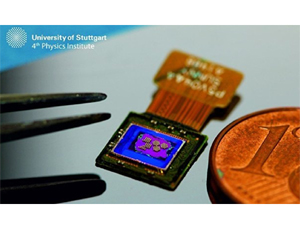



Date:29/06/16
 Scientists have used 3D printing to create the world’s tiniest lens, which is just twice the width of a human hair. Its makers claim the lens could lead to cameras the size of a grain of salt, revolutionising health imaging, clandestine surveillance, robotics and drone technology.
Scientists have used 3D printing to create the world’s tiniest lens, which is just twice the width of a human hair. Its makers claim the lens could lead to cameras the size of a grain of salt, revolutionising health imaging, clandestine surveillance, robotics and drone technology.
In a paper published in Nature Photonics this June 27, 2016, Dr Timo Gissibl from Stuttgart University (Germany) and colleagues explain how they 3D printed a triplet lens devices by combining three of the lenses into a 'pinhead' device. The ‘pinhead’ device is capable of razor sharp pictures and can be printed directly onto image sensors other than optical fibres, such as those used in digital cameras, or even the tip of an endoscope – a camera used for internal examination of organs. Such technology could also be deployed in virtually invisible security monitors, or mini-robots with "autonomous vision".
Dr Gissibl and colleagues wrote:"Current lens systems are restricted in size, shape and dimensions by limitations of manufacturing. Multi-lens elements with non-spherical shapes are required for high optical performance and to correct for aberrations when imaging at wide angles and large fields. Here, we present a novel concept in optics that…opens the new field of 3D printed micro- and nano-optics with complex lens designs." The team believes its 3-D printing method may represent "a paradigm shift".
Dr Timo Gissibl and his colleagues used a device which emits short pulses of light to harden material onto which the 3D multi-lens systems could be printed.
In tests they showed that objects 3 mm from the lens were successfully reproduced at the other end of a 1.7 metre (5.6-foot) long tube. The 'imaging system' is thin enough to fit inside a typical syringe needle, allowing for delivery into a human organ, or even the brain.
"Endoscopic applications will allow for non-invasive and non-destructive examination of small objects in the medical as well as the industrial sector," they wrote.
Dr Gissibl added, “The unprecedented flexibility of our method paves the way towards printed optical miniature instruments such as endoscopes, fibre-imaging systems for cell biology, new illumination systems, miniature optical fibre traps, integrated quantum emitters and detectors, and miniature drones and robots with autonomous vision.”
World's smallest 3D printed lens revealed
 Scientists have used 3D printing to create the world’s tiniest lens, which is just twice the width of a human hair. Its makers claim the lens could lead to cameras the size of a grain of salt, revolutionising health imaging, clandestine surveillance, robotics and drone technology.
Scientists have used 3D printing to create the world’s tiniest lens, which is just twice the width of a human hair. Its makers claim the lens could lead to cameras the size of a grain of salt, revolutionising health imaging, clandestine surveillance, robotics and drone technology.In a paper published in Nature Photonics this June 27, 2016, Dr Timo Gissibl from Stuttgart University (Germany) and colleagues explain how they 3D printed a triplet lens devices by combining three of the lenses into a 'pinhead' device. The ‘pinhead’ device is capable of razor sharp pictures and can be printed directly onto image sensors other than optical fibres, such as those used in digital cameras, or even the tip of an endoscope – a camera used for internal examination of organs. Such technology could also be deployed in virtually invisible security monitors, or mini-robots with "autonomous vision".
Dr Gissibl and colleagues wrote:"Current lens systems are restricted in size, shape and dimensions by limitations of manufacturing. Multi-lens elements with non-spherical shapes are required for high optical performance and to correct for aberrations when imaging at wide angles and large fields. Here, we present a novel concept in optics that…opens the new field of 3D printed micro- and nano-optics with complex lens designs." The team believes its 3-D printing method may represent "a paradigm shift".
Dr Timo Gissibl and his colleagues used a device which emits short pulses of light to harden material onto which the 3D multi-lens systems could be printed.
In tests they showed that objects 3 mm from the lens were successfully reproduced at the other end of a 1.7 metre (5.6-foot) long tube. The 'imaging system' is thin enough to fit inside a typical syringe needle, allowing for delivery into a human organ, or even the brain.
"Endoscopic applications will allow for non-invasive and non-destructive examination of small objects in the medical as well as the industrial sector," they wrote.
Dr Gissibl added, “The unprecedented flexibility of our method paves the way towards printed optical miniature instruments such as endoscopes, fibre-imaging systems for cell biology, new illumination systems, miniature optical fibre traps, integrated quantum emitters and detectors, and miniature drones and robots with autonomous vision.”
Views: 544
©ictnews.az. All rights reserved.Similar news
- The mobile sector continues its lead
- Facebook counted 600 million active users
- Cell phone testing laboratory is planned to be built in Azerbaijan
- Tablets and riders outfitted quickly with 3G/4G modems
- The number of digital TV channels will double to 24 units
- Tax proposal in China gets massive online feedback
- Malaysia to implement biometric system at all entry points
- Korea to build Green Technology Centre
- Cisco Poised to Help China Keep an Eye on Its Citizens
- 3G speed in Azerbaijan is higher than in UK
- Government of Canada Announces Investment in Green Innovation for Canada
- Electric cars in Azerbaijan
- Dominican Republic Govt Issues Cashless Benefits
- Spain raises €1.65bn from spectrum auction
- Camden Council boosts mobile security





















